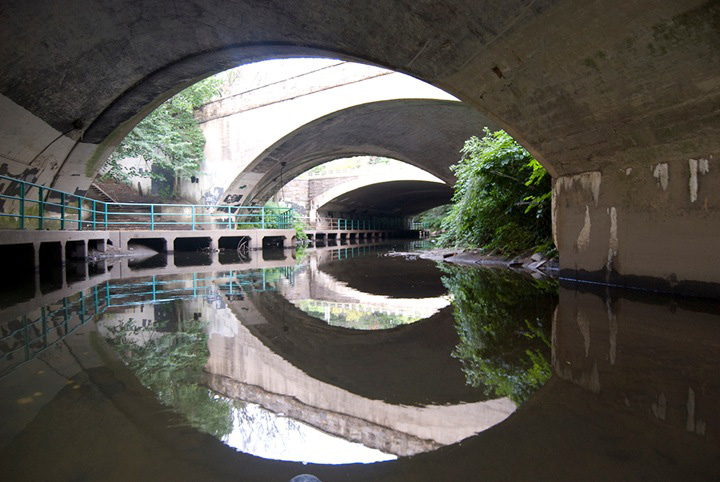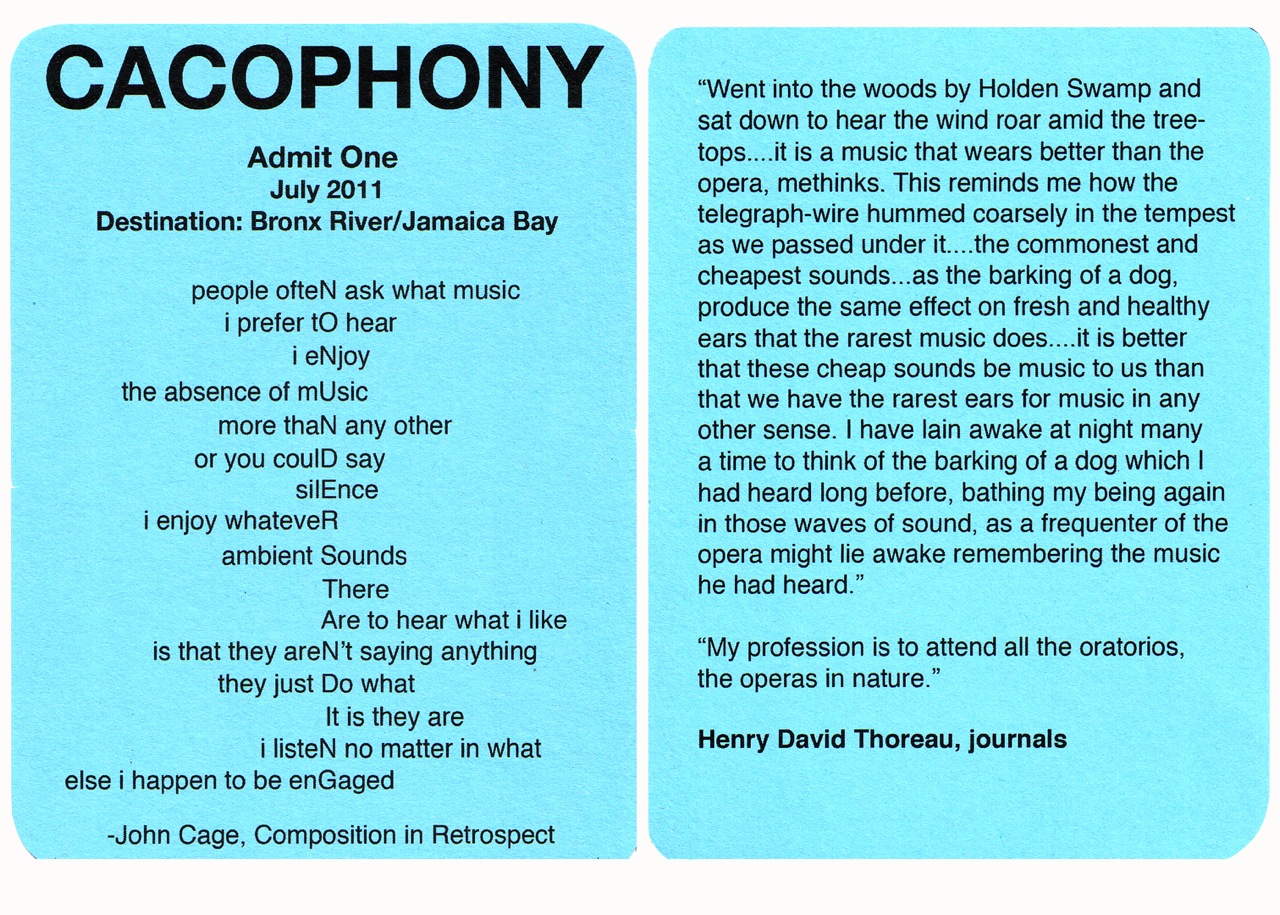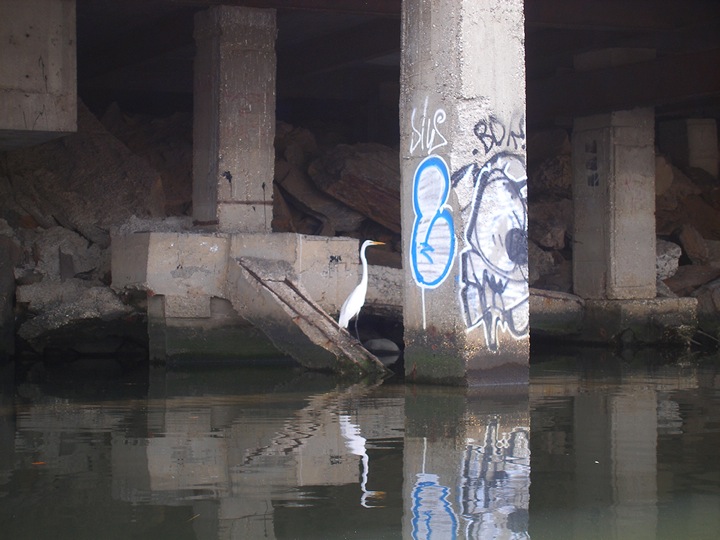
Gina Siepel. CACOPHONY, 2011, underpass on the Bronx River. Photo credit: Anna Reynolds.
In July 2011, the artist Gina Siepel paddled down the Bronx River with four strangers. This series of excursions in the northernmost borough of New York City, along with four similar trips led by Siepel in the Jamaica Bay Wildlife Refuge in Queens, were part of a performance called CACOPHONY. The event was part of the Sea Worthy Festival, hosted by EFA Project Space, Gowanus Studio Space, and Flux Factory. When purchasing tickets, interested participants were informed they had to be able to lift forty pounds and have basic paddling skills in order to accompany the artist on what was described as “a listening trip.” Siepel met each companion before sunrise at Shoelace Park, at the intersection of Bronx Avenue and 219th Street, and after brief introductions, they set out in silence.
The physical ticket for the event also clued participants into the artist’s thoughts on silence: on the front was a reproduction of a mesostic from John Cage’s Composition in Retrospect, and on the back were excerpts from Henry David Thoreau’s journals. Both figures have strongly influenced Siepel’s practice. Thoreau, the author and naturalist, was a major exponent of the American idea of self-reliance. Moreover, his ideas and drawings were incorporated into many of Cage’s avant-garde musical and visual artworks. Cage abandoned abstract painting early in his career in favor of music and other works that eschewed individual expression. Likewise, Siepel traded her practice as a painter for performance-based works. All three artists share a belief that silence heightens an awareness of presence. Siepel explained, “I consider silence an additive concept.”1

Gina Siepel. CACOPHONY, 2011. Printed ticket given to participants. ©Gina Siepel
Alongside the influences of Cage and Thoreau, the idea for CACOPHONY resulted from an earlier riparian performance by Siepel, called A River Twice. The two-year project, titled after a quote by the Greek philosopher, Heraclitus—“No man ever steps in the same river twice, for it’s not the same river and he’s not the same man”—began with the construction of a traditional wooden workboat in 2008. Siepel invited seven guests—including historians, ornithologists, and philosophers—onto her boat to navigate the waters of the Kennebec River in Maine. These trips and the resultant conversations were recorded, culminating in a video essay. Following the seven excursions narrated by her guests, Siepel was unaccompanied on the eighth trip, for which she said, “The river was my guide.” In the trips guided by her guests, the sounds of the river were only heard in the interstices of the conversations, but Siepel’s final trip along the Kennebec allowed her to tune into her environment.

Gina Siepel. CACOPHONY, 2011. Scrap metal processing, Bronx River. Photo credit: Anna Reynolds.
For CACOPHONY, she decided to offer a similar experience to other participants, without conversation or the presence of a videographer. On those early morning trips down the Bronx River, Siepel saw a turtle, beaver, a dead dog, and many different types of birds, yet few images of these sightings during the performances exist. Siepel only made audio recordings of the trips because she believed that taking pictures or videos would distract participants from the benefits of moving together in silence: being present and listening to the water, the natural world, and the urban background. As a former resident of the city, Siepel explained, “To understand the city through the geography of the river was a radically new experience for me.” Traveling in silence down the Bronx River with a stranger made the city, once familiar to the artist, able to be seen and absorbed anew.

Gina Siepel. CACOPHONY, 2011. Canoe at Soundview Park, Bronx River. Photo credit: Anna Reynolds.
A few weeks after Siepel finished this series of performances, while driving along the Bronx River Parkway, she spotted a great blue heron flying overhead. Canoeing along the Bronx River made Siepel aware of the diversity of wildlife within the five boroughs. When Siepel saw that heron, she knew where it lived and understood the migratory paths of other similar birds. With projects such as CACOPHONY, she wants to remind participants of the complex and hybrid nature of contemporary spaces: in the city, there exists unexpected yet ineluctable wildness, in the same way that in silence is total noise.

Gina Siepel. CACOPHONY, 2011. Great Egret on the Bronx River. Photo credit: Gina Siepel.
Gina Siepel (born 1974, West Valley, NY) holds a BFA in painting from State University of New York, Purchase, and an MFA from the Maine College of Art, and she attended the Skowhegan School of Painting and Sculpture. Her work has been shown at many venues, including the deCordova Sculpture Park and Museum in Lincoln, Massachusetts, and the Colby College Museum of Art in Waterville, Maine. In 2012, a second iteration of CACOPHONY (with the choreographer Sara Smith) was performed at Mildred’s Lane, the collaborative living experiment cofounded by the artists J. Morgan Puett and Mark Dion. Siepel lives and works in Greenfield, Massachusetts.
1. All of Siepel’s quotes are from a conversation with the author, on December 11, 2015, in Greenfield, Massachusetts.



